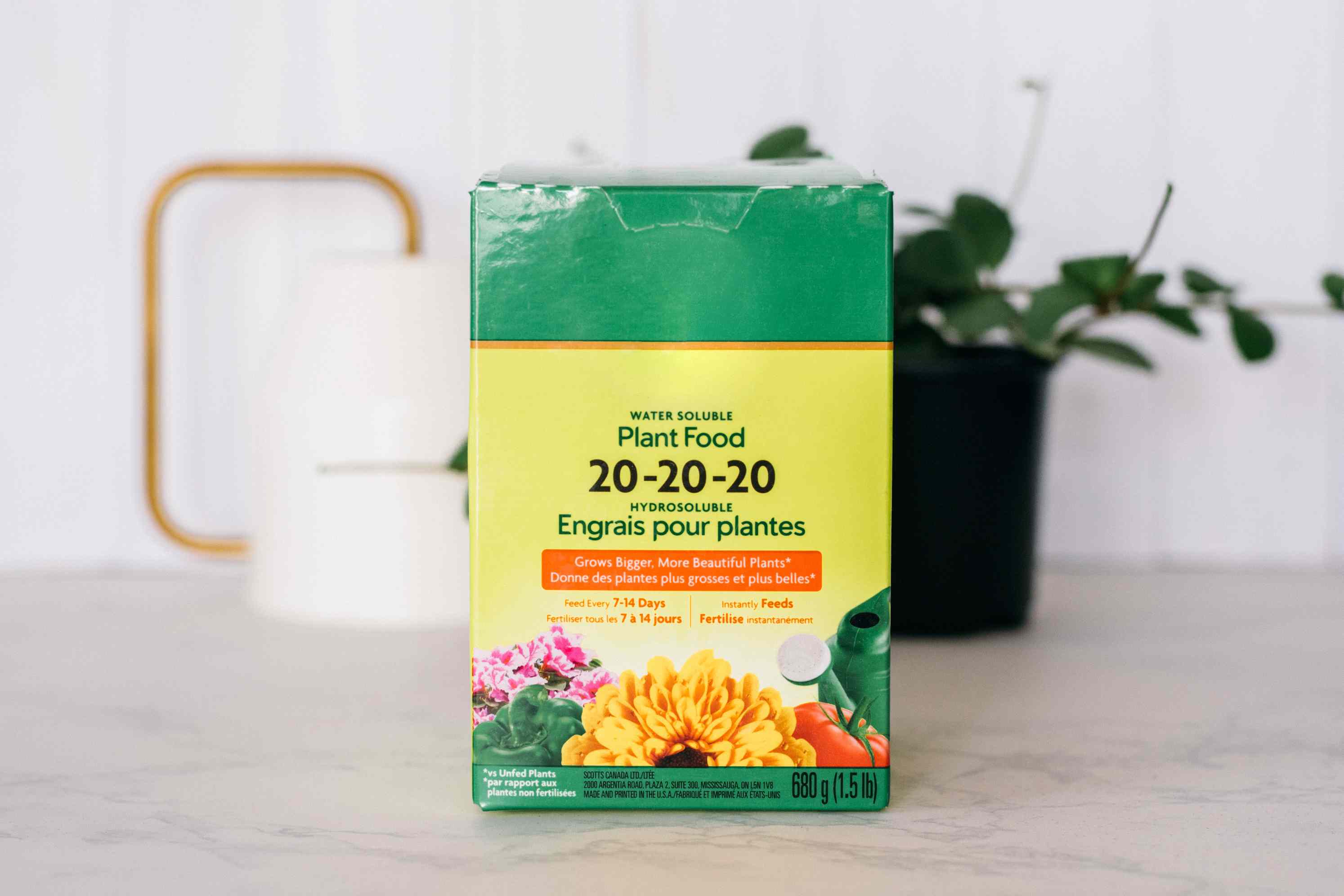Home>Gardening News and Trends>What Does NPK Mean In Fertilizer


Gardening News and Trends
What Does NPK Mean In Fertilizer
Modified: January 22, 2024
Discover the latest news on NPK fertilizer and what it means for your gardening needs. Stay updated with the latest trends and insights in the world of fertilizers.
(Many of the links in this article redirect to a specific reviewed product. Your purchase of these products through affiliate links helps to generate commission for Chicagolandgardening.com, at no extra cost. Learn more)
Table of Contents
Introduction
Fertilizers play a crucial role in helping plants grow and thrive. They provide essential nutrients that are necessary for plant development, flowering, and fruiting. Among the various types of fertilizers available, NPK fertilizers are widely used in agriculture and gardening. NPK stands for Nitrogen (N), Phosphorus (P), and Potassium (K), which are the three primary nutrients required by plants in larger quantities. Understanding the significance of NPK and its role in fertilizers is essential for successful gardening and crop cultivation.
When it comes to fertilizers, it’s not just about providing plants with any nutrients. Different plants have distinct nutritional needs that depend on their growth stage, environmental conditions, and nutrient availability in the soil. The NPK ratio on fertilizer packaging indicates the relative amounts of each nutrient in the formulation. This ratio is a crucial factor in determining the fertilizer’s suitability for specific plants or crops.
In this article, we will delve into the details of NPK fertilizers, exploring the roles of nitrogen, phosphorus, and potassium in plant growth. We will also discuss the importance of the NPK ratio and how it varies for different types of plants. Additionally, we will examine organic versus synthetic NPK fertilizers to provide a comprehensive understanding of this vital aspect of gardening and agriculture.
Understanding NPK
NPK fertilizers are formulated to provide plants with the essential nutrients they need for optimal growth and development. Let’s take a closer look at the three main components of NPK and their roles in plant nutrition.
Nitrogen (N) is a vital nutrient that plays a crucial role in plant growth. It is responsible for promoting lush foliage, vigorous vegetative growth, and increasing overall plant size. Nitrogen is a key component of chlorophyll, the green pigment found in plants that is essential for photosynthesis. Adequate nitrogen availability ensures healthy leaf development and helps plants withstand environmental stressors.
Phosphorus (P) is essential for energy transfer and storage in plants. It promotes strong root development, flowering, and fruiting. Phosphorus is involved in various metabolic processes, including the conversion of sunlight into chemical energy, the synthesis of DNA and RNA, and the activation of enzymes. Adequate phosphorus levels in the soil can enhance plant productivity, improve nutrient uptake, and enhance overall plant health.
Potassium (K), often referred to as potash, is crucial for overall plant health and resilience. It plays a vital role in regulating water uptake and retention, improving disease resistance, and enhancing tolerance to drought and temperature extremes. Potassium is involved in numerous physiological processes such as photosynthesis, protein synthesis, and enzyme activation. It helps plants withstand environmental stressors and ensures proper nutrient balance and overall plant vigor.
The NPK ratio on fertilizer packaging indicates the relative amounts of each nutrient in the formulation. For example, a fertilizer with an NPK ratio of 10-5-5 contains 10% nitrogen, 5% phosphorus, and 5% potassium. The ratio helps gardeners and farmers choose the right fertilizer for their specific needs, taking into account the nutritional requirements of different plants at different growth stages.
Having a basic understanding of NPK fertilizers and their components is essential for maximizing plant growth and achieving healthy, robust plants. The next sections will explore the roles of nitrogen, phosphorus, and potassium in greater detail, as well as guide you in determining the ideal NPK ratio for different types of plants.
The Role of Nitrogen in Fertilizer
Nitrogen (N) is a fundamental nutrient for plant growth and development. It is a key component of amino acids, proteins, enzymes, and chlorophyll, which are essential for various biochemical processes in plants. Let’s explore the role of nitrogen in more detail.
One of the primary functions of nitrogen is to promote healthy leaf development and vibrant green foliage. It is responsible for stimulating cell division and elongation, leading to increased plant height and overall size. Nitrogen deficiency can result in stunted growth, pale or yellowing leaves, and reduced plant vigor.
Furthermore, nitrogen is crucial for photosynthesis, the process by which plants convert sunlight into energy. It is a vital component of chlorophyll, the pigment responsible for capturing light energy. Adequate nitrogen levels ensure higher rates of photosynthesis, which leads to increased plant biomass production and improved crop yields.
In addition to promoting growth and photosynthesis, nitrogen plays a key role in enhancing plant metabolism. It serves as a building block for amino acids, which are the building blocks of proteins. Proteins are essential for cell structure and function, as well as for various biochemical processes within plants. Nitrogen is also involved in the synthesis of nucleic acids, which are essential for genetic coding and inheritance.
Nitrogen availability in the soil can also influence plant resistance to environmental stressors. It helps plants withstand drought, temperature extremes, and disease pressures. Adequate nitrogen levels enhance plant resilience, ensuring that plants can overcome and recover from adverse conditions more effectively.
However, it is important to note that while nitrogen is critical for plant growth, excessive nitrogen application can have adverse effects. Nitrogen runoff from agricultural fields can contribute to water pollution, negatively impacting aquatic ecosystems. Furthermore, excessive nitrogen can lead to imbalanced nutrient uptake, hinder flowering and fruiting, and make plants more susceptible to certain diseases and pests.
When using nitrogen-based fertilizers, it is important to follow proper application rates and timings to ensure that plants receive adequate but not excessive nitrogen levels. This will help promote healthy growth, optimize nutrient utilization, and minimize environmental impacts.
Understanding the role of nitrogen in fertilizers is essential for maintaining healthy plants and maximizing crop productivity. In the next sections, we will explore the role of phosphorus and potassium in fertilizers, as well as understand the importance of the NPK ratio in achieving optimal plant nutrition.
The Role of Phosphorus in Fertilizer
Phosphorus (P) is a vital nutrient for plant growth and development. It plays a crucial role in various metabolic processes and is essential for energy transfer and storage within plants. Let’s dive into the role of phosphorus in more detail.
One of the primary functions of phosphorus is promoting root development and growth. Phosphorus is involved in the synthesis of adenosine triphosphate (ATP), a molecule that provides energy for cellular processes. Adequate phosphorus levels in the soil stimulate root elongation and branching, leading to enhanced nutrient uptake and improved plant establishment.
Phosphorus is also essential for flower and fruit development. It promotes the formation and transfer of sugars, which are necessary for the development of floral structures and the production of seeds and fruits. Adequate phosphorus levels can result in improved flowering, seed set, and fruit quality.
In addition to its role in energy transfer and reproductive processes, phosphorus plays a crucial role in several biochemical processes within plants. It is involved in the synthesis and activation of enzymes, which are essential for various metabolic reactions. Phosphorus is also a component of nucleic acids (DNA and RNA) and phospholipids, both of which are critical for genetic coding, protein synthesis, and cell membrane structure.
Phosphorus is essential for efficient nutrient uptake in plants. It activates and enhances the uptake of other nutrients, such as nitrogen and potassium, by facilitating their movement within the plant. Adequate phosphorus levels can improve nutrient utilization and reduce the risk of nutrient deficiencies.
While phosphorus is crucial for plant growth, it is important to note that its availability and accessibility in the soil can be limited. Phosphorus, in its natural form, may be present in soil but in forms that are not readily accessible to plants. Consequently, phosphorus fertilizers are often applied to ensure adequate levels for plant growth.
When using phosphorus-based fertilizers, it is essential to apply them judiciously. Excessive phosphorus application can lead to nutrient imbalances, environmental pollution, and water degradation. It is crucial to follow recommended application rates and consider soil testing to determine the appropriate amount of phosphorus that the plants require.
Understanding the role of phosphorus in fertilizers is essential for promoting healthy root development, optimal nutrient uptake, and overall plant growth. In the next section, we will explore the role of potassium in fertilizers and its importance in plant nutrition.
The Role of Potassium in Fertilizer
Potassium (K) is a crucial nutrient for plant growth and development. It plays a vital role in various physiological processes and is essential for overall plant health and resilience. Let’s delve into the role of potassium in more detail.
One of the primary functions of potassium is regulating water uptake and retention in plants. Potassium helps plants maintain proper water balance, ensuring that they can absorb and utilize water efficiently. It aids in the opening and closing of stomata, the small pores on leaves, which helps control water loss through transpiration. Adequate potassium levels in plants can improve drought tolerance and reduce the risk of wilting.
Potassium also plays a crucial role in nutrient transportation within plants. It enhances the movement of sugars, amino acids, and other nutrients, facilitating their distribution to various plant tissues. This ensures that all parts of the plant receive the necessary nutrients for optimal growth and development.
In addition to its role in regulating water uptake and nutrient transportation, potassium is involved in numerous physiological processes within plants. It is essential for photosynthesis, the process by which plants convert sunlight into energy. Potassium helps activate enzymes involved in photosynthesis and enhances the efficiency of photosynthetic reactions. Adequate potassium levels contribute to higher rates of photosynthesis and increased biomass production.
Potassium is also crucial for strengthening plant cell walls, improving plant structure, and increasing resistance to disease and pests. It helps plants develop thicker cell walls, providing structural support and reducing the risk of lodging. Furthermore, potassium activates defense mechanisms in plants, making them more resistant to fungal, bacterial, and insect attacks.
Moreover, potassium is involved in regulating various enzyme activities within plants, contributing to overall metabolic functions. It facilitates protein synthesis and activates enzymes essential for carbohydrate metabolism, including the conversion of starches to sugars. Potassium also plays a role in the synthesis of adenosine triphosphate (ATP), the primary energy molecule in cells.
While potassium is an essential nutrient for plant growth, it is important to maintain proper balance with other nutrients, such as nitrogen and phosphorus. Imbalanced nutrient levels can hinder nutrient uptake and utilization, affecting overall plant health. Therefore, it is crucial to consider the ideal NPK ratio for different plants and ensure that potassium levels are adequate relative to nitrogen and phosphorus.
Understanding the role of potassium in fertilizers is crucial for promoting healthy water regulation, efficient nutrient transport, and overall plant vigor. In the following sections, we will explore the importance of the NPK ratio and how it varies for different types of plants.
Importance of NPK Ratio
The NPK ratio on fertilizer packaging plays a crucial role in determining the suitability of the fertilizer for specific plants or crops. It indicates the relative proportions of nitrogen (N), phosphorus (P), and potassium (K) in the fertilizer formulation. Understanding the importance of the NPK ratio is essential for achieving optimal plant nutrition and promoting healthy plant growth.
Each nutrient in the NPK ratio serves distinct roles in plant growth and development. Nitrogen promotes leaf development and photosynthesis, phosphorus stimulates root growth and flowering, and potassium enhances water regulation and overall plant health. The ratios of these nutrients in a fertilizer formulation can vary, and selecting the appropriate ratio depends on the specific needs of the plants being grown.
The NPK ratio helps ensure that plants receive the right balance of nutrients throughout their growth stages. Different plants have varying nutritional needs at different stages. For instance, young plants may require higher nitrogen levels to support vigorous leaf growth, while flowering plants may benefit from higher phosphorus levels to promote robust flower formation.
Choosing the right NPK ratio is also important for specific gardening goals. For example, gardeners focused on growing vegetables may opt for a fertilizer with a higher nitrogen content to promote green, leafy growth. On the other hand, those growing fruit trees may select a fertilizer with a higher phosphorus content to encourage flower development and fruit production.
The ideal NPK ratio will also depend on the existing nutrient levels in the soil. Conducting a soil test can help determine the nutrient deficiencies or excesses present in the soil, allowing gardeners to choose a fertilizer with the appropriate NPK ratio to address these imbalances.
It is worth noting that while the NPK ratio is essential, it should not be the sole factor considered when selecting a fertilizer. Other factors such as soil pH, organic matter content, and specific plant requirements should also be taken into account. Additionally, the NPK ratio should be viewed as a guideline rather than a strict rule, as the actual nutrient requirements of plants can vary based on environmental conditions and other factors.
In summary, the NPK ratio is an important factor to consider when selecting a fertilizer. It helps ensure that plants receive the right balance of nutrients for healthy growth and development. However, it should be used in conjunction with other factors such as soil conditions and specific plant requirements to tailor fertilizer application for optimal results.
Different NPK Ratios for Different Plants
Plants have varying nutritional needs, and different crops and species require specific NPK ratios to thrive and produce optimally. Understanding the optimal NPK ratios for different plants is essential for providing targeted nutrition and achieving successful cultivation.
When it comes to vegetables, leafy greens such as lettuce and spinach benefit from higher nitrogen (N) levels. This promotes lush leaf growth and enhances the overall yield. On the other hand, root vegetables like carrots and beets require higher phosphorus (P) levels to support robust root development and ensure healthy growth below ground.
When it comes to fruiting plants, such as tomatoes and peppers, a balanced NPK ratio is often recommended. This provides sufficient nitrogen for foliage development, phosphorus for flower formation, and potassium (K) for fruit production. A well-balanced NPK ratio helps achieve a healthy plant structure and encourages high-quality, abundant harvests.
For flowering plants and ornamentals, a higher phosphorus content in the NPK ratio is desirable. This encourages profuse flowering and vibrant blooms. Phosphorus aids in the development of healthy flower buds and enhances the production of robust, colorful flowers.
In contrast, plants grown primarily for their fruits, such as citrus trees or berry bushes, benefit from a higher potassium content in the NPK ratio. Potassium promotes overall plant health, improves fruit quality, and enhances the plant’s ability to withstand environmental stressors and diseases.
It is important to note that while specific NPK ratios are recommended for different types of plants, it is still necessary to consider other factors. These factors include soil conditions, climate, and the specific requirements of the plant variety being grown. Soil testing can provide valuable insights into the nutrient composition of the soil, allowing gardeners to customize the NPK ratio based on the plant’s needs and existing nutrient levels.
Furthermore, it’s worth remembering that plants have different nutrient requirements at different growth stages. During the early stages of growth, plants typically require higher nitrogen levels to support vegetative growth. As plants transition to flowering and fruiting stages, the emphasis may shift to higher phosphorus and potassium levels for optimal flower and fruit development.
Adapting the NPK ratio to meet the specific needs of different plants is crucial for achieving successful cultivation and maximizing yield and quality. By understanding the unique nutritional requirements of various plant types, gardeners can provide tailored nutrition and ensure that their plants thrive throughout their growth cycle.
NPK Fertilizer Recommendations
Choosing the right NPK fertilizer for your plants is essential to ensure they receive the necessary nutrients for healthy growth and development. While the ideal NPK ratio may vary depending on specific plant types and growth stages, here are some general recommendations:
- For general gardening purposes, a balanced NPK ratio of 10-10-10 or 20-20-20 is commonly used. This provides a moderate amount of nitrogen, phosphorus, and potassium, suitable for a wide range of plants.
- For plants that require vigorous vegetative growth and lush foliage, such as leafy greens and lawns, a fertilizer with a higher nitrogen content, such as 20-5-5 or 16-6-4, is recommended.
- For flowering plants, choose a fertilizer with a higher phosphorus content, such as 10-20-10 or 5-10-5. This will promote profuse flower formation and enhance overall bloom quality.
- For fruiting plants, such as tomatoes or peppers, a fertilizer with a balanced NPK ratio, such as 8-8-8 or 10-10-10, is suitable. This will ensure that the plants receive balanced nutrition for both vegetative growth and fruit production.
- For acid-loving plants like azaleas, rhododendrons, and blueberries, use a fertilizer formulated specifically for acid-loving plants. These fertilizers usually have a lower pH and higher sulfur content to meet the specific needs of these plants.
It is important to follow the recommended application rates provided on the fertilizer packaging. Overapplication of fertilizers can lead to nutrient imbalances, nutrient runoff, and potential damage to plants.
Additionally, consider the amount of organic matter and micronutrients already present in the soil. If the soil is rich in organic matter and micronutrients, a balanced NPK fertilizer may be sufficient. However, if the soil lacks certain nutrients, you may need to supplement with specific nutrient-rich fertilizers or consider organic options.
Another aspect to consider is the release time of the fertilizer. Some fertilizers are slow-release, gradually providing nutrients over an extended period. This is particularly useful for plants that have continuous nutrient needs or for gardeners who prefer to fertilize less frequently.
Lastly, regular soil testing can help monitor nutrient levels and fine-tune the NPK ratio based on the specific needs of your plants. Soil tests provide valuable insights into the nutrient composition of the soil, allowing you to make informed decisions regarding fertilizer application.
By considering the specific needs of your plants, following recommended application rates, and conducting soil tests, you can select the appropriate NPK fertilizer and provide the best possible nutrition for healthy and productive plants.
Organic Vs. Synthetic NPK Fertilizers
When it comes to NPK fertilizers, there are two main categories: organic and synthetic. Understanding the differences between organic and synthetic fertilizers can help you make an informed choice for your gardening or farming practices. Here’s a comparison of organic and synthetic NPK fertilizers:
Source:
Organic fertilizers are derived from natural sources, including plant and animal materials. Examples of organic fertilizers include compost, manure, bone meal, and seaweed extract. These sources provide a wide range of nutrients, micronutrients, and organic matter that nourish the soil and sustain the long-term health of plants.
Synthetic fertilizers, on the other hand, are chemically manufactured. They are typically composed of concentrated forms of nitrogen (N), phosphorus (P), and potassium (K), derived from non-organic materials such as ammonia, phosphoric acid, and potassium chloride. Synthetic fertilizers provide readily available nutrients in precise ratios, allowing for more targeted and immediate plant uptake.
Effectiveness:
Organic fertilizers work slowly, as they need to undergo microbial decomposition and breakdown into plant-available forms. This slow-release nature helps nutrients become available over an extended period, reducing the risk of nutrient leaching and minimizing the potential for nutrient burn. However, it may take time for the benefits of organic fertilizers to become noticeable.
Synthetic fertilizers, on the other hand, provide nutrients in readily available forms, allowing for rapid plant uptake. This immediate availability can lead to rapid growth and quick responses, making synthetic fertilizers particularly suitable for correcting severe nutrient deficiencies or providing quick boosts of nutrients for specific growth stages.
Sustainability and Environmental Impact:
Organic fertilizers are seen as a more sustainable option because they are derived from natural materials and contribute to the recycling and reuse of organic waste. They improve soil structure, increase water-holding capacity, and promote beneficial microbial activity. Additionally, organic fertilizers reduce the risk of groundwater contamination and have a lower carbon footprint.
Synthetic fertilizers, while effective in providing concentrated nutrients, often have a higher environmental impact. Excessive application of synthetic fertilizers can lead to nutrient runoff, contributing to water pollution and algal blooms in water bodies. Additionally, the manufacturing process of synthetic fertilizers consumes energy and fossil fuels.
Long-Term Soil Health:
Organic fertilizers improve soil health and fertility by adding organic matter and beneficial microorganisms. They stimulate soil biological activity, enhance nutrient cycling, and improve overall soil structure and moisture retention. Using organic fertilizers can lead to long-term soil health and sustainability.
Synthetic fertilizers, while providing quick nutrients for plants, do not contribute to organic matter content or improve soil structure. Continuous use of synthetic fertilizers without organic amendments can lead to soil degradation, reduced microbial activity, and nutrient imbalances over time.
Ultimately, the choice between organic and synthetic NPK fertilizers depends on various factors, including the specific needs of your plants, sustainability goals, and the condition of your soil. Consider incorporating a combination of both approaches, with a focus on organic fertilizers for long-term soil health and synthetic fertilizers for targeted nutrient interventions when necessary.
Conclusion
NPK fertilizers play a significant role in providing essential nutrients that plants need for healthy growth and development. Understanding the roles of nitrogen, phosphorus, and potassium in fertilizers is crucial for successful gardening and crop cultivation.
Nitrogen is responsible for promoting lush foliage and vigorous vegetative growth. It plays a crucial role in photosynthesis, protein synthesis, and overall plant metabolism.
Phosphorus is essential for root development, flower formation, and energy transfer within plants. It is involved in various metabolic processes, including the synthesis of DNA, RNA, and enzymes, ensuring optimal plant growth and reproduction.
Potassium is vital for water regulation, nutrient transportation, and overall plant health. It enhances drought tolerance, disease resistance, and supports important physiological processes, such as photosynthesis and enzyme activation.
The NPK ratio on fertilizer packaging is an important consideration in selecting the right fertilizer for specific plants. Different plants have varying nutritional needs, and matching the NPK ratio to these needs helps provide targeted nutrition for optimal growth and productivity.
It is essential to consider other factors, such as soil conditions and plant requirements, in addition to the NPK ratio. Soil testing can provide valuable insights into nutrient deficiencies or excesses, enabling gardeners to customize fertilizer application to meet the specific needs of their plants.
Furthermore, the choice between organic and synthetic NPK fertilizers depends on individual preferences and goals. Organic fertilizers promote long-term soil health and sustainability, while synthetic fertilizers provide quick and targeted nutrient availability. Combining both approaches can yield optimal results by focusing on organic fertilizers for soil health and sustainability and using synthetic fertilizers for specific nutrient interventions when required.
By understanding the significance of NPK fertilizers and tailoring nutrient application to plant requirements, gardeners and farmers can promote healthy plant growth, enhance crop yields, and ensure long-term soil fertility.






